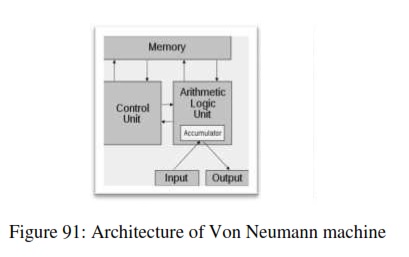CHAPTER ELEVEN
HISTORICAL DEVELOPMENT OF COMPUTERS
11.4.4. John Neumann Machine
John von Neumann is a mathematician from Hungarian invented the stored program concept in the 1940s. Von Neumann stored program concepts was used to invent computers that can store both the instructions or programs and data/information internally. That means such computers are run by instructions inside. Therefore, they need not to be programmed externally, using switches, cables, punched cards, or punched tapes. The architecture of most of the current digital pr personal computers is based on the Von Neumann architecture. Von Neumann machine is divided into four main parts:
- Central Arithmetical unit
- Central Control unit
- Memory
- Input/output devices
1. Arithmetical unitArithmetic unit is the center for calculations- Subtraction, multiplication and division.
2. Control unit
Control unit controls the moving of signals, data and information within the computer system. E.g. from the input device- keyboard to the CPU, Memory and finally to the out put device.
4. Memory
Memory is the store of the computer- stores both data and the instructions that tells the computer what to do, when, how and where.
5. Input/output devices
Input/output unit(s) is the link between the user and the computer. This relates to the interaction between the user, the hardware such as the keyboard/mouse, CPU, memory and output device-monitor/printer. Below is the diagram of the John Neumann machine architecture.
11.4.5. Personal Computers (PCS)
Personal computers (PCs) are the most common computers that we know today. These are the computers we use in our daily lives- in our houses, business premises, schools, government offices. Personal computers (PCs) are more efficient and reliable than the ancient computers such as the Mark 1, ENIAC, EDVAC and UNIVAC computers. The efficiency and reliability of the personal computers are as the result of the invention and the use of integrated circuits and microprocessors.
11.4..1. Basic features of personal computers
Some of the basic features of personal computers are:
- Personal computers used microprocessors made from silicon.
- Graphical user Inter phase (GUI). The personal computers are the first computers to use GUI. GUI enables the user to manipulate different programs or parts of the computer through graphics called icons, which are situated on the desk top.
- Mouse and keyboard. The Personal computers are the first computers which use mouse and other in put devices.
- Multitasking features. Multitasking enables the computer user to open several programs on the same computer at the same time.
- Personal computers can be linked together to form networks, which led to the invention of the Internet (network of computers containing data and information).
| Click to page 36 | Page 37 | Click to page 38 |
Copyright2015@Digital Vision Digital content Development Center.
www.digitalvision.net.ng
